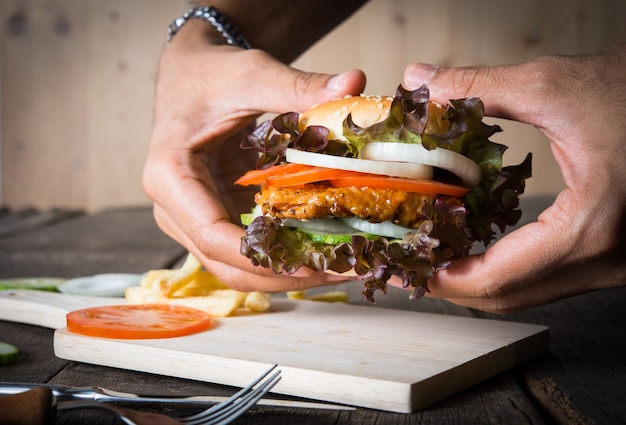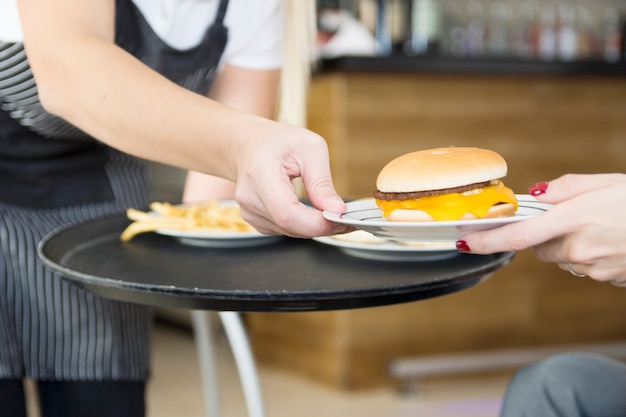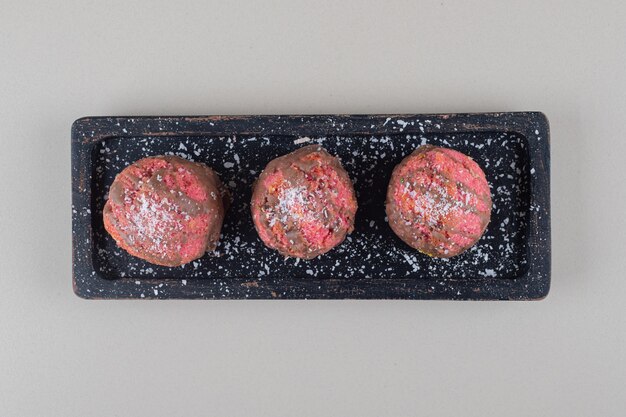We've all been there: burger cravings hit hard, but the freezer holds the only available patties. A wave of panic washes over you – can you even cook a burger from frozen? Well, my friends, let me assure you, not only is it possible, but it can be a delicious and time-saving hack. I've been perfecting this art for years, and I'm here to share my secrets.
This article isn't just a guide to cooking frozen burgers; it's a journey through the joys of burger-making, from the best frozen patties to irresistible toppings and sides. Buckle up, burger lovers, because we're about to embark on a culinary adventure that's both practical and tasty!
Part 1: Busting the Frozen Burger Myths

There's a persistent rumour circulating among burger aficionados – frozen burgers are inferior to their fresh counterparts. They'll be dry, flavourless, and frankly, not worth the effort. But let me tell you, those rumours are flat-out wrong.
While I'll never deny the satisfaction of grilling a juicy, freshly-made patty, I'm here to proclaim that frozen burgers, when treated right, can be just as delicious. It's all about understanding how frozen meat behaves and using the right techniques.
The Science Behind Frozen Burgers
Let's break down the science a bit. The freezing process doesn't actually destroy flavour, it simply traps it within ice crystals. It's true that some volatile flavour compounds might be lost, but the core flavour remains intact. The real challenge is managing moisture.
Here's the thing: frozen meat takes longer to cook through because of those ice crystals. But that's also what helps it retain moisture during cooking! Those crystals act like tiny little water reservoirs, preventing the burger from drying out. It's a bit of a culinary paradox, but a welcome one indeed.
Part 2: Choosing the Right Frozen Burger

Now, the fun begins – finding your perfect frozen patty! The freezer aisle is a veritable burger buffet, offering everything from classic beef to creative veggie and chicken options. But how do you navigate this frozen landscape?
Here are a few tips to guide your quest:
- Go for Quality: Don't settle for generic brands. Pick a trusted name, and check the ingredients. Look for burgers made with real meat and minimal additives. Avoid those with excessive fillers or preservatives.
- Think About Taste: Do you crave the classic beef burger experience, the satisfying crunch of a chicken patty, or the exciting world of plant-based alternatives? Whatever your heart desires, there's a frozen patty out there for you.
- Consider Your Cooking Method: Some frozen burgers are specifically designed for grilling, while others shine on a skillet. Pay attention to the packaging, and choose a patty suited for your cooking style.
My Personal Frozen Burger Favourites
Over the years, I've sampled a fair share of frozen burgers, and I've found a few true gems. Here are some of my go-to brands, showcasing different types of patties:
- For a Classic Beef Burger: [Brand Name] consistently delivers juicy, flavourful burgers that are perfect for a simple yet satisfying experience.
- For a Tasty Chicken Option: [Brand Name] excels in making chicken patties that are moist and flavorful, avoiding the dryness that often plagues chicken burgers.
- For a Plant-Based Alternative: [Brand Name] has a range of veggie burgers that impress. My personal favourite is their [Specific Burger Name], which features a [Describe flavour and texture] that's both hearty and delicious.
Part 3: To Thaw or Not To Thaw – That Is the Question

Here's where the opinions diverge – do you thaw your frozen burgers before cooking? Some swear by it, while others believe it's a culinary sin. I stand firmly in the camp of cooking frozen burgers directly.
Here's why I prefer to skip the thawing step:
- Thawing can Lead to Moisture Loss: When you thaw frozen meat, it naturally releases some of its moisture. This can result in a drier burger, which is the opposite of what we want.
- Cooking from Frozen Helps Lock in Moisture: As we discussed earlier, those ice crystals in the frozen meat act like tiny moisture retainers. They release their water content gradually during cooking, keeping the burger juicy and succulent.
If You Must Thaw:
If you absolutely must thaw your burgers, do it the right way. The safest method is to thaw them slowly in the refrigerator overnight. Alternatively, you can thaw them in a bowl of cold water, ensuring the water is changed every 30 minutes to maintain a cold temperature.
Avoid thawing your burgers at room temperature, as this can encourage the growth of harmful bacteria. It's better to play it safe and follow the recommended methods.
Part 4: Cooking Frozen Burgers Like a Pro
Alright, the stage is set, and your chosen frozen patties are ready for their culinary transformation. Now, let's delve into the art of cooking frozen burgers to perfection.
Here's my tried-and-tested guide, covering both grill and pan methods:
- Preheat Your Grill or Pan: A hot surface is crucial for achieving a crispy outer crust while keeping the inside juicy.
- Don't Overcrowd: Give those burgers some space to breathe! If you're cooking multiple patties, cook them in batches to ensure even cooking.
- Resist the Urge to Press: Avoid flattening your burgers with a spatula. This only forces out the precious juices, leaving you with a dry and disappointing result.
- Cook to the Right Temperature: Frozen burgers require a bit more time than fresh patties to reach the safe internal temperature of 160°F (71°C). Use a meat thermometer to ensure your burgers are cooked through and safe to eat.
Grilling Glory
For that classic burger experience, fire up your grill! Get it nice and hot, then sear those frozen patties for a few minutes per side, creating a delicious crust.
Pan-Fried Perfection
No grill? No problem! A cast-iron pan is your best friend for pan-frying frozen burgers. Heat it over medium-high heat, add a bit of oil, and cook those patties for about 5-7 minutes per side, achieving a lovely golden brown color.
Part 5: The Art of Burger Assembly
Your burgers are cooked to perfection, and now it's time for the grand finale – building the masterpiece that will satisfy those burger cravings.
Here's my approach to assembling a truly memorable burger:
- Build a Flavorful Base: Start with a toasted bun, preferably a brioche bun for its buttery richness. A warm, slightly crisp bun adds a delightful textural contrast.
- Layer on the Deliciousness: Now comes the fun part – adding your favourite toppings. Go for classic combinations like lettuce, tomato, and onion, or explore more adventurous options like roasted peppers, caramelized onions, or avocado.
- Don't Forget the Sauce: A dollop of mayonnaise, ketchup, mustard, or a special sauce can elevate your burger to new heights. Experiment with different sauces to find your perfect pairing.
My Burger Assembly Tips:
Here's how I like to layer my burger for optimal flavour and stability:
- Start with the Bottom Bun: Spread a thin layer of sauce on the bottom bun, creating a flavourful base for your burger.
- Add the Patty: Place your cooked burger patty on top of the sauce, ensuring it's centered on the bun.
- Layer on the Toppings: Add your toppings, starting with the larger ones, like lettuce and tomato, and work your way down to smaller items like onion and pickles. This ensures that everything stays in place.
- Finish with the Top Bun: Place the top bun on top of the toppings and gently press down, securing the delicious layers and creating a satisfying burger experience.
Part 6: side dishes that Steal the Show
Your burgers are ready to be devoured, but let's not forget the supporting cast! A delicious side dish can elevate your burger experience to a whole new level.
Here are a few of my favourite burger companions:
- crispy fries: A classic for a reason! Nothing beats a big pile of golden, crispy fries to complement your burger.
- Creamy Coleslaw: The tangy sweetness of coleslaw is a perfect counterpoint to the richness of a burger, providing a refreshing contrast.
- baked potato: A loaded baked potato with all the fixings is a hearty and satisfying side that stands up to the flavour of your burger.
- Fresh Salad: For a lighter option, a fresh salad with a vinaigrette dressing is a great choice. It adds a burst of freshness and vibrant colours to your meal.
My Side Dish Inspiration:
I love to experiment with different side dishes to add variety to my burger meals. Here are a couple of my recent creations:
- sweet potato Fries with a Sprinkle of Smoked Paprika: These fries offer a delicious twist on the classic, adding a touch of sweetness and smoky flavour.
- grilled corn on the Cob with a Lime-Cilantro Butter: This side dish brings a refreshing element to the meal, with the sweetness of corn enhanced by the zesty lime and fragrant cilantro.
Part 7: Burger Drinks that Quench Your Thirst
No burger feast is complete without a refreshing drink to wash down those delicious flavours. From classic sodas to craft beers, the choices are endless.
Here are a few of my go-to burger beverages:
- Iced Tea: A classic, refreshing choice that pairs well with any kind of burger. It's simple, satisfying, and always a crowd-pleaser.
- Root Beer: This sweet and bubbly drink adds a touch of nostalgia to your burger experience.
- Craft Beer: For a more sophisticated option, I recommend a hoppy IPA or a crisp lager. The bitterness of an IPA can cut through the richness of a burger, while a lager provides a clean and refreshing counterpoint.
- Milkshake: For a sweet treat, you can't go wrong with a classic milkshake. It's a decadent and indulgent option that complements the richness of your burger.
My Burger Drink Pairings:
I've learned that certain drinks complement specific burgers perfectly. Here are a few of my favourite pairings:
- Beef Burger with a Classic IPA: The hoppy bitterness of the IPA cuts through the richness of the beef burger, creating a balanced and satisfying flavour profile.
- Chicken Burger with a Light Lager: The crispness of the lager balances out the chicken's flavour, providing a refreshing and clean taste.
- Veggie Burger with a Root Beer Float: The sweetness of the float complements the earthy flavours of the veggie patty, creating a harmonious and delicious pairing.
Part 8: The Burger Aftermath
You've enjoyed your burger feast, and now it's time to deal with those post-burger leftovers. Here are a few tips to ensure your leftovers are handled with care:
- Store Leftover Burgers Properly: If you have any leftover burgers, refrigerate them in an airtight container. They'll stay fresh for a few days and can be enjoyed in sandwiches, salads, or even as a topping for a baked potato.
- Don't Throw Away Those Buns: If you have leftover buns, you can use them to make a delicious breakfast sandwich, or even toast them for a simple snack.
- Use Leftover Fries for a Tasty Snack: Reheat those leftover fries for a quick and easy snack.
My Leftover Burger Hacks:
Here are a few creative ways to use up leftover burgers and avoid food waste:
- Burger Sliders: Make mini burgers with leftover patties and buns.
- Burger Salad: Dice up leftover burgers and add them to a salad for a satisfying and protein-packed meal.
- Burger Soup: Use leftover patties to make a hearty and flavorful soup.
FAQs
Here are some frequently asked questions about cooking frozen burgers, addressing common concerns and offering helpful solutions.
1. How Long Do Frozen Burgers Take to Cook?
Frozen burgers take longer to cook than fresh ones because of the ice crystals. Allow for 5-7 minutes per side on a hot grill or pan.
2. Can I Cook Frozen Burgers in the Oven?
Yes, you can cook frozen burgers in the oven. Preheat your oven to 400°F (200°C) and cook the patties for 15-20 minutes, flipping them halfway through.
3. Can I Cook Frozen Burgers on a George Foreman Grill?
Yes, you can cook frozen burgers on a George Foreman grill. Follow the manufacturer's instructions for cooking time and temperature, as they may vary depending on the model.
4. Can I Freeze Cooked Burgers?
Yes, you can freeze cooked burgers. Let them cool completely, then store them in an airtight container or freezer bag for up to 3 months. They can be reheated in the microwave or oven.
5. Can I Grill Frozen Burgers on a Gas Grill?
Yes, you can grill frozen burgers on a gas grill. Preheat the grill to medium-high heat and cook the patties for 5-7 minutes per side, flipping them when they develop a nice crust.
Now that you're equipped with all the knowledge and tips, go forth and conquer those frozen burgers! Embrace the convenience, unleash your creativity, and enjoy a delicious burger experience that's both budget-friendly and flavourful. Happy burgering!
Everyone is watching

Prime Rib Roast Cooking Time Chart: Per Pound Guide
Cooking TipsPrime rib roast. Just the name conjures images of lavish dinners, crackling fires, and hearty laughter. It’s ...

How Long to Bake Potatoes in the Oven (Perfect Every Time)
Cooking TipsBaked potatoes are a staple in my kitchen. They're incredibly versatile, delicious, and surprisingly easy to m...

Perfect Rice Every Time: The Ultimate Guide to Cooking Rice
Cooking TipsAs a self-proclaimed foodie, I've always been a bit obsessed with rice. It's the foundation of countless cuisi...

The Ultimate Guide to Cooking Asparagus: Tips, Techniques, and Recipes
Cooking TipsAsparagus. The mere mention of this spring delicacy conjures up images of vibrant green spears, crisp and burs...

Ultimate Guide to Cooking the Perfect Thanksgiving Turkey
Cooking TipsThanksgiving. Just the word conjures up images of overflowing tables laden with delicious food, the scent of r...
